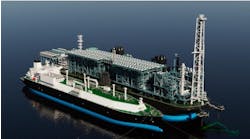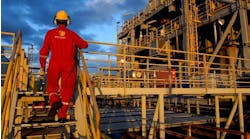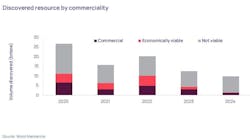Competition won't deter usage
Jaime Kammerzell
Gulf of Mexico Editor
Deep and remote locations in harsh operating environments have created potential oil and gas transportation challenges that will require new and creative technologies.
The Gulf of Mexico shelf pipeline infrastructure is extensive. This vast infrastructure – made up of pipelines and platforms – provides the capacity to bring GoM deepwater oil and gas production to shore. As deepwater discoveries become more common, pipelines are going farther into deeper Gulf of Mexico waters than they have before.
Deepwater delivery
The deepwater Gulf of Mexico has experienced a substantial increase in leasing, exploration, development, and production activities and this activity is expected to continue, according to the Minerals Management Service. As the deepwater trend grows in the Gulf, challenges to bring oil to shore have surfaced. GulfTerra, an independent infrastructure provider in the Gulf, typically oversizes deepwater pipeline and platform projects to allow for additional future usage. The company's plan is to look at the whole area, look at future potential, and oversize the facility and infrastructure for the possibility of future development and expansion when it makes sense. By executing this "hub and spoke" concept, GulfTerra has made marginal and smaller deepwater fields more economical to produce.
GulfTerra also builds flexibility into its deepwater infrastructure, typically using 16-in. and larger pipelines designed to accommodate increasing development. Also, the deeper the water, the more steel is required to prevent the pipeline from collapsing. Large-diameter pipelines in deepwater often have a wall thickness in excess of 1 in. Only a limited number of pipe mills in the world can produce that type of pipe, explains Bart Heijermans, vice president of GulfTerra Energy Partners.
One of the biggest deepwater challenges for pipeline transportation is the availability of equipment. There are only a few pipelay vessels in the world that can lay large-diameter lines. Pipelines, once installed, are highly reliable. GulfTerra's pipeline system uptime is over 99%. "We have very little downtime, Heijermans said. "Reliability is very important for our customers."
The alternative
Tension leg platforms, spars, and semisubmersibles work economically with pipelines in the GoM, Heijermans said. An FPSO in combination with a shuttle tanker – a concept that has not been used in the Gulf yet – could transport oil; however, gas still has to flow through a pipeline to the market.
"Because you are building a gas pipeline, the price of an oil pipeline will be relatively lower, as there are synergies between the gas pipeline and oil pipeline installation," Heijermans said. "A significant part of the cost associated with laying pipelines is fixed. If you are already building a gas pipeline, you don't have to incur all these fixed costs for the oil pipeline," Heijermans said.
GulfTerra has an extensive pipeline system in the Gulf of Mexico.
null
Discoveries up to 120 mi south of the shelf will in all likelihood be tied back to existing pipelines. It is GulfTerra's view that FPSOs will eventually work in the GoM, but only for discoveries 120 mi south of the shelf in very remote locations. Small fields out past 120 mi probably won't be developed on a stand-alone basis, no matter how it is transported to shore, Heijermans said. You have to look at larger fields with substantial reserves. GulfTerra believes that its pipelines can compete for the fields that are greater than 120 mi off the shelf. With larger fields, pipeline companies can extend infrastructure from existing deepwater pipelines.
Expansion
GulfTerra currently is finishing its longest oil pipeline system, Cameron Highway, which will be available this summer. The system is 380 mi long and will originate from the GulfTerra platform at Ship Shoal block 332. It runs parallel to the shelf for 120 mi, then heads northwest to the Texas City and Port Arthur markets. Cameron Highway will move BP, BHP, and Unocal's production from the Holstein, Mad Dog, and Atlantis deepwater fields. These discoveries will use the Caesar deepwater pipeline, which will bring the oil production to the shelf. From there, the oil production will flow through the Cameron Highway system to the two Texas markets.
A vast pipeline system gives the operator options for production. "With the Marco Polo oil pipeline, (which will be connected to the Allegheny oil pipeline), we took advantage of a Y-assembly that we installed in our Allegheny oil pipeline in a water depth of 2,800 ft," Heijermans said. "This allowed us to offer a more competitive service to our customer and to fill excess capacity in our pipeline. The Allegheny oil pipeline will transport the oil to Ship Shoal block 332. From there, producers can access either the Poseidon system to bring production to south Louisiana or the Cameron Highway system to bring production to Texas. It is important to be able to access several markets to get the highest net back," Heijermans said.
Healthy competition
FPSOs, shuttle tankers, and technology still in the development stage will find their niche in the deepwater Gulf of Mexico market, but pipelines are sure to continue. New technology, increased availability of pipeline installation vessels and suitable pipe, and expanding infrastructure will secure the pipeline's role in transporting deepwater discoveries to shore.




